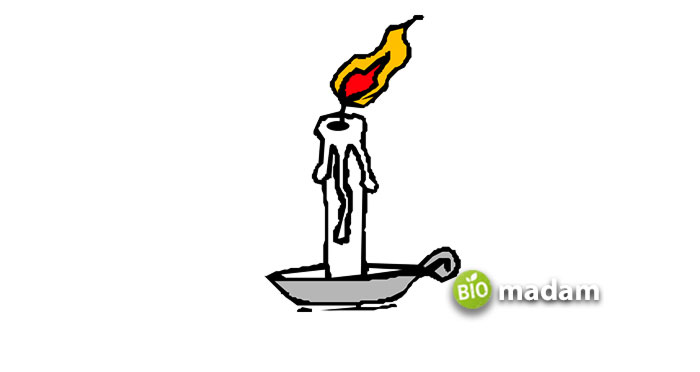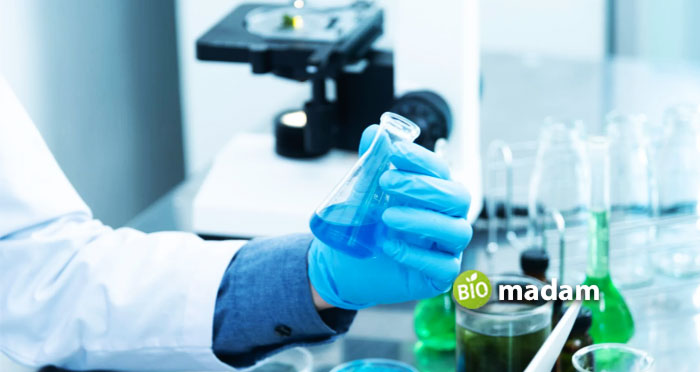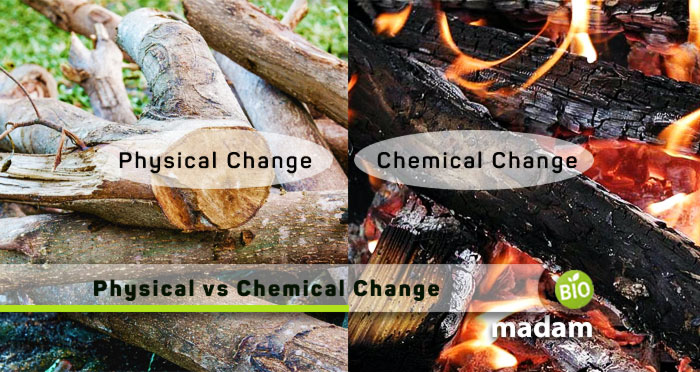Out of many reactions occurring around us and in research laboratories, some are physical, and some are chemical. Some scientists also suggest that physical changes are not reactions as they do not produce another compound. Provided this information, we can say that physical and chemical changes are different in composition.
In a chemical change, the reaction causes a change in the composition of the reacting material. In contrast, a physical change attributes to a change in the form, smell, or texture of the substance without any alteration in the chemical structure. Most physical changes are reversible, but reversing chemical reactions is difficult.
Comparison Table
| Factors | Physical Change | Chemical Change |
| Change Type | Temporary | Permanent |
| Reversibility | Yes | No |
| Product Formation | No | Yes |
| Energy Change | No | Yes |
| Examples | Wood cutting, and ice melting | Burning wood, and frying egg |
What is a Physical Change?
Physical change refers to the change in the form of a substance. It could be a change in how it looks, feels smells, or a difference in size. However, physical changes are not permanent and may be reversed. Considering the changes in the state or form, the molecules may rearrange themselves, but the composition does not change, and no new product is produced. Besides modifying the shape or texture, a physical change may also affect mass, volume, viscosity, solubility, density, etc.

Characteristics of Physical Change
Some of the fundamental characteristics of physical change are:
- The most important characteristic of a physical change is the sustenance of the chemical composition of the subject that may be changed when going through a chemical change.
- Physical changes are reversible. You may achieve the previous form of the substance.
- Physical changes involve no energy changes. For example, if you heat the material and thermally expand it, it will release the heat when coming back to its original form.
- Physical changes are less complex than chemical changes.
Examples of Physical Change
Numerous phenomena happening around us represent a physical change. Some examples of physical change include:
- Dissolving salt in water is one of the most common examples of physical change. It is also demonstrated to students in schools to explain a physical change better. The salt dissolves in water easily and quickly when warmed. Though, it can also be removed by heating the solution (evaporation).
- Turning ice into water and water into ice also exhibits a physical change that frequently occurs in our freezers, and on glaciers. When water turns into ice or ice turns into water, the composition of water does not change.
- Slicing a lemon, slicing, logs, and burning a candle is also some of the prominent physical changes around us.
What is a Chemical Change?
Opposed to physical change, chemical changes are typically not reversible and involve absorption and emission of energy. You can easily point out chemical reactions when practicing in the lab. Chemical changes not only alter the look of the substance but also affect the chemical composition. A chemical reaction leading to a chemical change usually changes the structure of the reactants and results in a new product.

Characteristics of Chemical Change
Some of the fundamental characteristics of chemical change are:
- Chemical changes transform the chemical composition, leading to new bonds and creating another substance.
- The changes that occur by chemical means are irreversible in most cases. While you may remove the rust from a surface by laser, reversing a hard-boiled egg to a raw egg is not possible.
- Chemical changes involve the emission and absorption of energy or heat to form a new product. The change in chemical composition also moves the mass and results in either additional or subtraction of mass from either side of the equation.
Examples of Chemical Change
- Digestion is a common example of a chemical change as everything you eat is metabolized and broken down into components. They come in contact with stomach acids, are absorbed in the bloodstream, and rest move out of the body. This whole process is not reversible and thus a chemical change.
- The burning of wood to ash is another example of chemical change as it is impossible to convert ash back to wood by applying heat or force, and the changes are permanent.
- Baking a cake is also a chemical change as eggs, flour, cocoa, and oil all are mixed and baked to form something that looks and tastes entirely different from what the ingredients looked or tasted like initially. It comparatively has more carbs and calories than any individual ingredient. You may say eggs + oil + flour + cocoa = cake where the product is different in composition than the reactants in their original form. It is a permanent change.
Differences Between Physical and Chemical Change
Definition
Physical Change
A physical change occurs when a change in shape, color, odor, or other physical properties is observed.
Chemical Change
A chemical reaction occurs as a result of a reaction of one or more reactants and forms a new product.
Reversibility
Physical Change
Physical changes are reversible, and you can obtain the original substance easily.
Chemical Change
However, chemical changes are mostly irreversible, and you cannot recover the original material.
New Product Formation
Physical Change
Physical changes do not lead to the formation of new products.
Chemical Change
Contrarily, chemical changes cause rebonding and form products chemically different from reactants.
Change Type
Physical Change
Physical changes are temporary and can be changed to the previous form.
Chemical Change
Whereas chemical reaction leads to permanent changes, it is challenging to reverse.
Energy Involved
Physical Change
No change of energy is involved in physical reactions.
Chemical Change
On the other hand, chemical reactions involve changes in energy and mass. Energy is either absorbed or emitted, causing mass changes in the reaction.
Examples
Physical Change
Tearing paper, ice melting, thermal expansion, etc.
Chemical Change
Frying an egg, rusting, photosynthesis, cellular respiration, etc.
Identifying a Chemical Change
While some changes are easy to identify as chemical or physical changes, some are not. You may observe a reaction that apparently looks like a physical change but produces changes in the composition and cannot be reversed. To ensure that no problems arise because of misjudging the type of reaction, here are a few tips to help you determine if the occurring change is physical or chemical. You can be sure about a change being chemical when:
- The reaction produces an odor. It could be pungent or sweet depending on the reaction but usually varies from the initial smell of the components.
- Gas is released, or you see vapors forming on the surface of the liquid.
- You observe a precipitate in the solution.
- Temperature changes occur in the surroundings due to an endothermic or exothermic reaction.
Sometimes a physical change might exhibit changes in a way that looks like a chemical change has occurred. Yet, if you see none of those mentioned above changes, it is likely a physical change.
The Bottom Line
Physical and chemical changes occur around us all the time. Some are driven by natural environmental factors, while others require laboratory intervention. Both are very different and can be identified based on their attributes like a change in physical form or chemical composition, reversibility, the release of gas, odor, heat, or the formation of a new product.

Anna has completed her degree in Pharmacy from the University of Hawaii. She is serving as a research assistant in a pharmaceutical company. She had a great interest in writing blogs, traveling to different parts of the US, and trying delicious recipes in her spare time.

